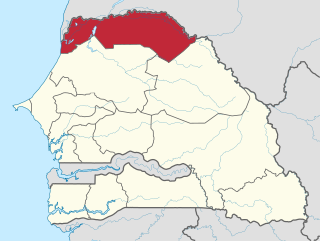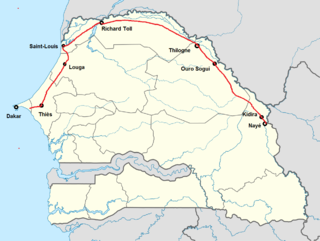Saint Louis, Saint-Louis or St. Louis may refer to a number of things, the great majority named after Saint Louis IX (1214–1270), a King of France and Catholic saint, and including the American city of St. Louis.

Louis Léon César Faidherbe was a French general and colonial administrator. He created the Senegalese Tirailleurs when he was governor of Senegal.

Thiès is the third largest city in Senegal with a population officially estimated at 320,000 in 2005. It lies 72 km (45 mi) east of Dakar on the N2 road and at the junction of railway lines to Dakar, Bamako and St-Louis. It is the capital of Thiès Region and is a major industrial city.

The cuisine of Senegal is a West African cuisine influenced by North African, French, and Portuguese cuisine and derives from the nation's many ethnic groups, the largest being the Wolof. Islam, which first penetrated the region in the 11th century, also plays a role in the cuisine. Senegal was a colony of France until 1960. Ever since its colonization, emigrants have brought Senegalese cuisine to many other regions.
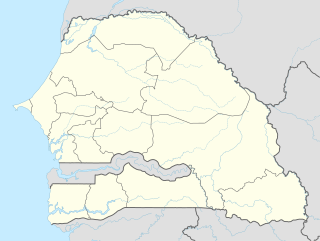
Saint-Louis Airport is an airport serving Saint-Louis, the capital of the Saint-Louis Region in Senegal. Saint-Louis is located near the Senegal River, and served as Senegal's capital until independence in 1960. It is 320 km (199 mi) north of Senegal's current capital in Dakar.

Saint-Louis Department is one of the 45 departments of Senegal, located in the Saint-Louis Region.

Kébémer is a town with commune status in Louga Region in north-west Senegal, lying midway between Thiès and Saint-Louis. It is the chief settlement, with a population of nearly 20,000 in 2013, of the department of the same name.
The "Four Communes" of Senegal were the four oldest colonial towns in French controlled west Africa. In 1848, the French Second Republic extended the rights of full French citizenship to the inhabitants of Saint-Louis, Dakar, Gorée, and Rufisque. While those who were born in these towns could technically enjoy all the rights of native French citizens, substantial legal and social barriers prevented the full exercise of these rights, especially by those seen by authorities as 'full blooded' Africans. Most of the African population of these towns were termed originaires: those Africans born into the commune, but who retained recourse to African and/or Islamic law. Those few Africans from the four communes who were able to pursue higher education and were willing to renounce their legal protections could 'rise' to be termed Évolué ('Evolved') and were nominally granted full French citizenship. Despite this legal framework, Évolués still faced substantial discrimination in Africa and the Metropole alike.
Gaston Berger University (GBU), or L'Université Gaston Berger (UGB), located some 12 km (7.5 mi) outside Saint-Louis, was the second university established in Senegal. Originally the University of Saint-Louis, it was renamed for Gaston Berger, an important French-Senegalese philosopher, on December 4, 1996.
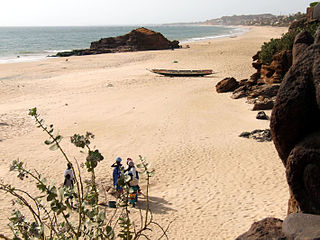
Tourism in Senegal is a vital part of the West African nation's economy.

Sioure is a town in the Podor Department of the Saint-Louis Region in Senegal, West Africa. It is situated on the left bank of the Senegal River on the island of Morfil about 250 km from the Atlantic Ocean.

Affiniam is a small town in the Bignona Department in the Ziguinchor Region of south-western Senegal. In 2002 it had a population of 1620 people. The town lies on the northern bank of the Casamance River. The area is dominated by rice farming.
The French conquest of Senegal started from 1659 with the establishment of Saint-Louis, Senegal, followed by the French capture of the island of Gorée from the Dutch in 1677, but would only become a full-scale campaign in the 19th century.

Edward Matthew Rice is an American prelate who is the bishop of the Diocese of Springfield-Cape Girardeau in Missouri. He was named Bishop of Springfield-Cape Girardeau by Pope Francis on April 26, 2016, and was installed on June 1, 2016. Rice previously served as auxiliary bishop of the Roman Catholic Archdiocese of St. Louis from 2010 to 2016.
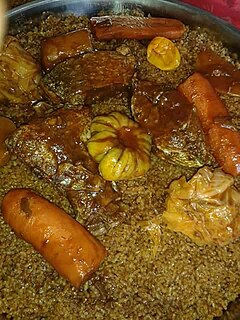
Tiep, is considered to be the national dish, the tiep is at the basis of food consumption in Senegal. Tiep or Ceebu jën means "rice fish" in Wolof. Historically, the tiep is commonly attributed to the city of Saint-Louis, in the nineteenth century. It consists of fish, usually White grouper, mixed with vegetables and rice. It can be adapted according to the means and products available. It is also the symbol of the Senegalese Terranga (hospitality): Family, visiting friends, and/or guests gather around a single dish in which everyone is using a spoon or a piece of bread.

Ziguinchor is the capital of the Ziguinchor Region, and the chief town of the Casamance area of Senegal, lying at the mouth of the Casamance River. It has a population of over 230,000. It is the second largest city of Senegal, but largely separated from the north of the country by The Gambia.

Ndioum is a town in the Saint-Louis Region of Senegal. It is in the Podor Department. The population in 2012 was 16,103, an increase from the 12,407 counted in 2002.

France–Senegal relations are foreign relations between France and Senegal. Both countries are full members of the Francophonie, and the World Trade Organization.
The following is a timeline of the history of the city of Saint-Louis, Senegal.

